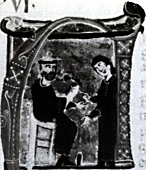Puy (society)

A puy or pui was a society, often organised as a guild or confraternity, sometimes along religious (Catholic) lines, for the patronisation of music and poetry, typically through the holding of competitions. The term puy derives from the Latin podium, meaning "a place to stand", referring probably to a raised platform from which either the contests delivered their works or the judges listened to them.[1] Puys were established in many cities in northern and central France, the Low Countries, and even England during the High Middle Ages and the Renaissance, usually encouraging composition in the Old French language, but also in Latin and Occitan.[2]
The typical puy was dedicated to the Virgin Mary. Membership was regulated by statutes to which those entering had to swear. These governed the election of executive positions within the puy and the benefits inhering in members. Members could be clerical or lay, male or female, noble or bourgeois, urban or rural. The earliest societies were organised around para-liturgical celebrations of the Marian feast days, but these evolved poetry competitions and eventually the competitions became the focus of the festivals. Music and sung performance were emphasised early on, but over the centuries the quality of the poetry came to dominate the members' concern and the puys of Normandy, especially popular from the fifteenth century on, were redefined in the seventeenth as literary academies. In this form they survived until the French Revolution.
A poetical society known, in a generic fashion, as the Puy Sainta Maria (Puy-Sainte-Marie), seems to have held contests at Le-Puy-en-Velay (Podium Aniciense) in the Occitan language under the patronage of Alfonso II of Aragon (1162–96). Among the troubadours known to have competed was the Monge de Montaudon, who received a Eurasian sparrowhawk as a prize for one piece. He is said by his vida to have held the "suzerainty" of the "court of Puy" (cour du Puy) until it was dissolved.[3]
The height of the French puys was in the Late Middle Ages. The puy would have an open invitation for competitions in several categories, with the theme, form, and refrain in each category stipulated.[4] Among the common most common forms were the formes fixes, the chant royal, jeu parti, , and ballade. The music was generally strophic monophony, but the puy at Évreux, founded in 1570, did accept two submissions of through-composed polyphony from Orlande de Lassus. The problems of adjudication at the contests spurned the production of several treatises on versification in the fifteenth and sixteenth centuries.[5] As in the Floral Games celebrated in southern France and Spain, the prizes awarded by the puys could be flowers, such as lilies or roses, or sometimes palms. These floral prizes could be redeemable for money. Besides these, the puys sometimes bestowed signet rings (engraved with imagery or poetry). The puys could attract professionals and men of fame, such as Jean Froissart, who competed and won at Abbeville, Lille, Tournai, and Valenciennes. They also attracted local amateurs.
Known puys[]
Notes[]
- ^ Elizabeth C. Teviotdale, "Puy", Grove Music Online, Oxford Music Online (accessed 16 August 2008). Adam de la Halle, who was associated with the Puy d'Arras, was the first to use the word to mean "a society holding literary competitions". There is some reason to believe that they may have their name from the Massif Central (a plateau in central France), where troubadour competitions are known from the period circa 1162–96. See also "Puy", The Oxford Companion to Music, Alison Latham, ed., Oxford Music Online (accessed 17 August 2008).
- ^ Die Meistersinger von Nürnberg, by Richard Wagner, may reflect a similar tradition to that of the puy in medieval Germany.
- ^ Margarita Egan, ed. (1984), The Vidas of the Troubadours (New York: Garland, ISBN 0-8240-9437-9), 70.
- ^ At Amiens every year, the refrain was publicised on a scroll alongside the Virgin and some illustrious contemporaries on a painted panel in the cathedral. Copies of these paintings, along with the winning chants royaux, from the period 1460–1517 are preserved in the Bibliothèque nationale de France, Paris, French MS 145, a work made for Louise of Savoy.
- ^ wrote Le grant et vrai art de pleine rhétorique (1521) for puy of Rouen.
- Confraternities
- Medieval French literature
- Medieval music genres
- Poetry organizations